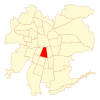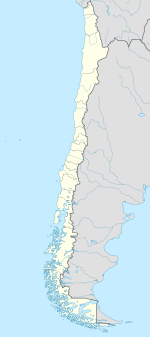San Miguel, Chile
San Miguel | |
|---|---|
|
| |
| Coordinates (alcalde's office): 33°29′09″S 70°38′58″W / 33.48583°S 70.64944°W | |
| Country | Chile |
| Region | Santiago Metro. |
| Province | Santiago |
| Founded | 10 August 1896 |
| Government | |
| • Type | Municipality |
| • Alcalde | Carol Bown (UDI) |
| Area | |
• Total | 9.5 km2 (3.7 sq mi) |
| As of 2002 Census | |
| Population (2017 projection)[3] | |
• Total | 107,954 |
| • Density | 11,000/km2 (29,000/sq mi) |
| • Urban | 107,954 |
| • Rural | 0 |
| Demonym | Sanmiguelino |
| Sex | |
| • Men | 37,836 |
| • Women | 41,036 |
| Time zone | UTC-4 (CLT[4]) |
| • Summer (DST) | UTC-3 (CLST[5]) |
| Area code | 56 + |
| Website | Municipality of San Miguel |
San Miguel (Spanish for "Saint Michael") is a commune of Chile located in Santiago Province, Santiago Metropolitan Region. It was founded on August 10, 1896.
History
[edit]The history of San Miguel dates back to the 16th century, when Gaspar Banda, assistant to the conquistador Diego de Almagro, created a hermitage to Saint Michael the Archangel in this territory in 1575.
At the beginning of the 19th century, the place emerged as an agricultural area, with wheat, barley and wine plantations.
The land was owned by Bernardo O'Higgins, liberator and father of the Chilean nation, who used it as his vacation home.
Ramón Subercaseaux brought wine strains directly from Bordeaux, France, and his wines acquired international prestige, especially at the Exposition Universelle of 1889 in Paris. His 1840 house is still preserved as a cultural center, and can be visited for free.
In 1881, the San Miguel Church was built on the same site as the 1575 hermitage.
The commune of San Miguel was founded on August 10, 1896.
At the beginning of the 20th century, the area began to be urbanized in the style of a European garden city, with large mansions, parks, squares and many trees in the streets. Later, the rest was urbanized in the style of a middle-class.
In the civic square, in front of the city hall, there is a statue of José Miguel Carrera designed in 1860 by Auguste Dumont, the same sculptor who made the statue of Napoleon, on the Vendôme Column in Paris.
Administration
[edit]As a commune, San Miguel is a third-level administrative division of Chile administered by a municipal council, headed by an alcalde who is directly elected every four years. The alcalde's office (alcaldía) is located at Gran Avenida No. 3418. The 2012–2016 alcalde is Julio Palestro Velásquez (PS). The communal council has the following members:
- Francia Palestro Contreras (PS)
- Luis Sanhueza Bravo (RN)
- Erika Martinez Osorio (PC)
- Carolina Onofri Salinas (RN)
- David Navarro Carachi (PRSD)
- Felipe Von Unger Valdés (UDI)
- Rodrigo Iturra Becerra (PDC)
- Ernesto Balcázar Gamboa (PS)
San Miguel belongs to the 28th electoral division (together with Pedro Aguirre Cerda and Lo Espejo) and the 8th senatorial constituency (Santiago East). It is represented in the Chamber of Deputies of the National Congress by the deputies Guillermo Teillier del Valle (PCCh) and Pedro Browne Urrejola (RN). It is represented in the Senate by senators Soledad Alvear (PDC) and Pablo Longueira (UDI).
Demographics
[edit]According to the 2002 census of the National Statistics Institute, San Miguel spans an area of 9.5 km2 (4 sq mi) and has 78,872 inhabitants (37,836 men and 41,036 women), and the commune is an entirely urban area. The population fell by 4.8% (3997 persons) between the 1992 and 2002 censuses.[3] The demonym for a person from San Miguel is sanmiguelino for a man or sanmiguelina for a woman.
- Other statistics
- Average annual household income: US$39,670 (PPP, 2006)[6][failed verification]
- Population below poverty line: 2.5% (2006)[7]
- Regional quality of life index: 82.17, high, 6 out of 52 (2005)[citation needed]
- Human Development Index: 0.765, 31 out of 341 (2003)[8]
Notable sanmiguelinos
[edit]
References
[edit]- ^ "Municipality of San Miguel" (in Spanish). Retrieved 14 September 2010.
- ^ "Administrative and Censual Political Division" (PDF) (in Spanish). Retrieved 13 September 2010.
- ^ a b c d "National Statistics Institute" (in Spanish). Retrieved 8 September 2010.
- ^ "Chile Time". WorldTimeZones.org. Archived from the original on 2007-09-11. Retrieved 2010-07-29.
- ^ "Chile Summer Time". WorldTimeZones.org. Archived from the original on 2007-09-11. Retrieved 2010-07-29.
- ^ "Regional Information System". Ministry of Planning of Chile (in Spanish). Archived from the original on 23 April 2008. Retrieved 14 September 2010.
- ^ "Poverty in the Santiago Metropolitan Region" (PDF). Ministry of Planning of Chile (in Spanish). Archived from the original (PDF) on August 24, 2007.
- ^ "The Trajectories of Human Development in the Communes of Chile (1994-2003)" (PDF). Government of Chile, Mideplán (in Spanish). UNDP. Archived from the original (PDF) on 7 July 2011. Retrieved 12 September 2010.
External links
[edit]- (in Spanish) Municipality of San Miguel




